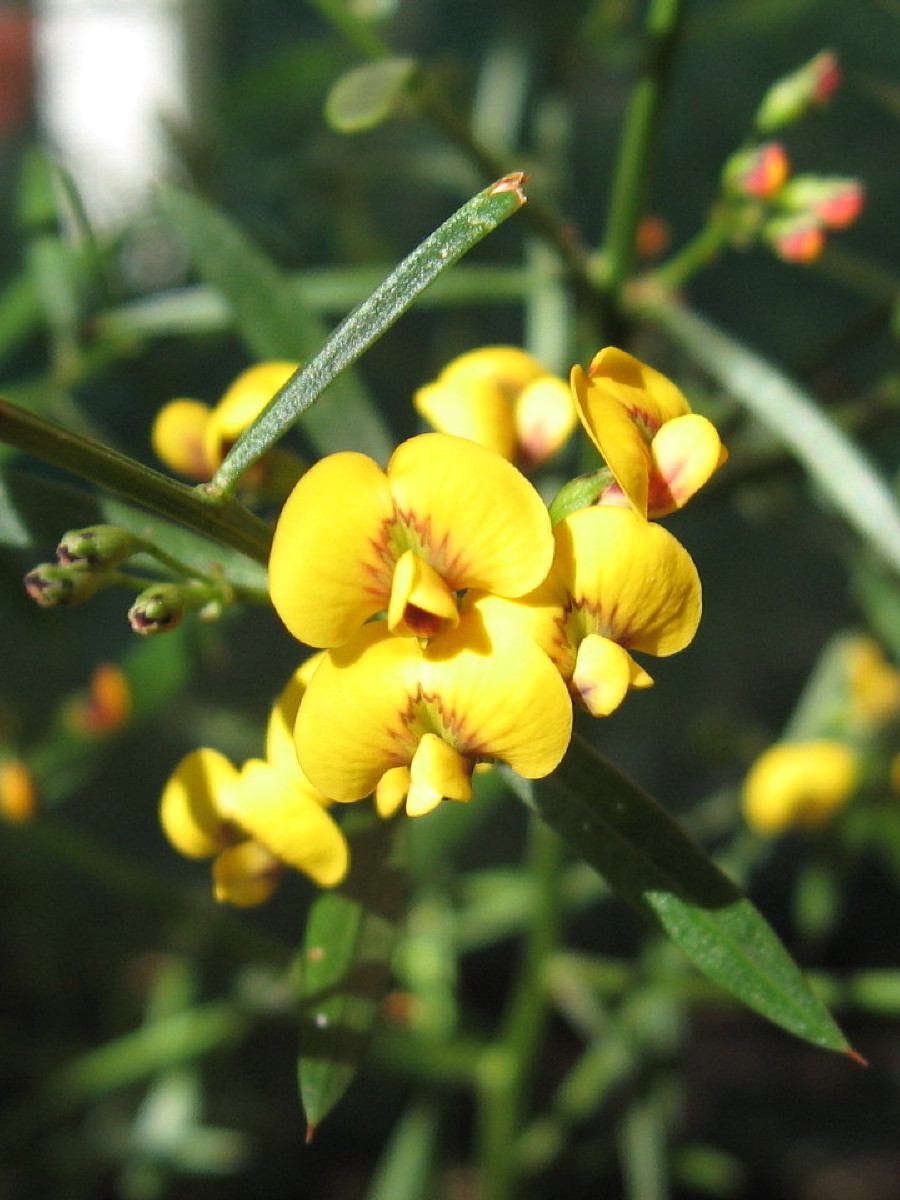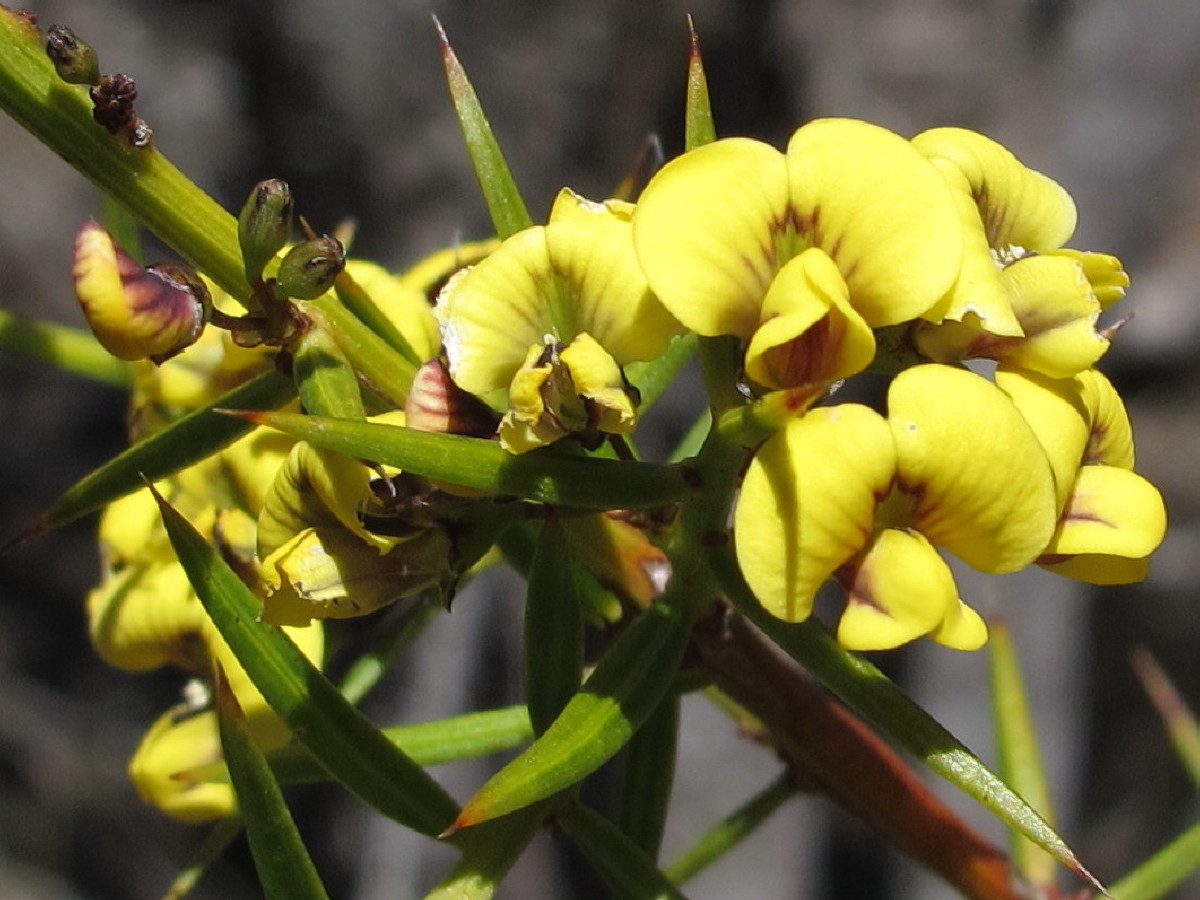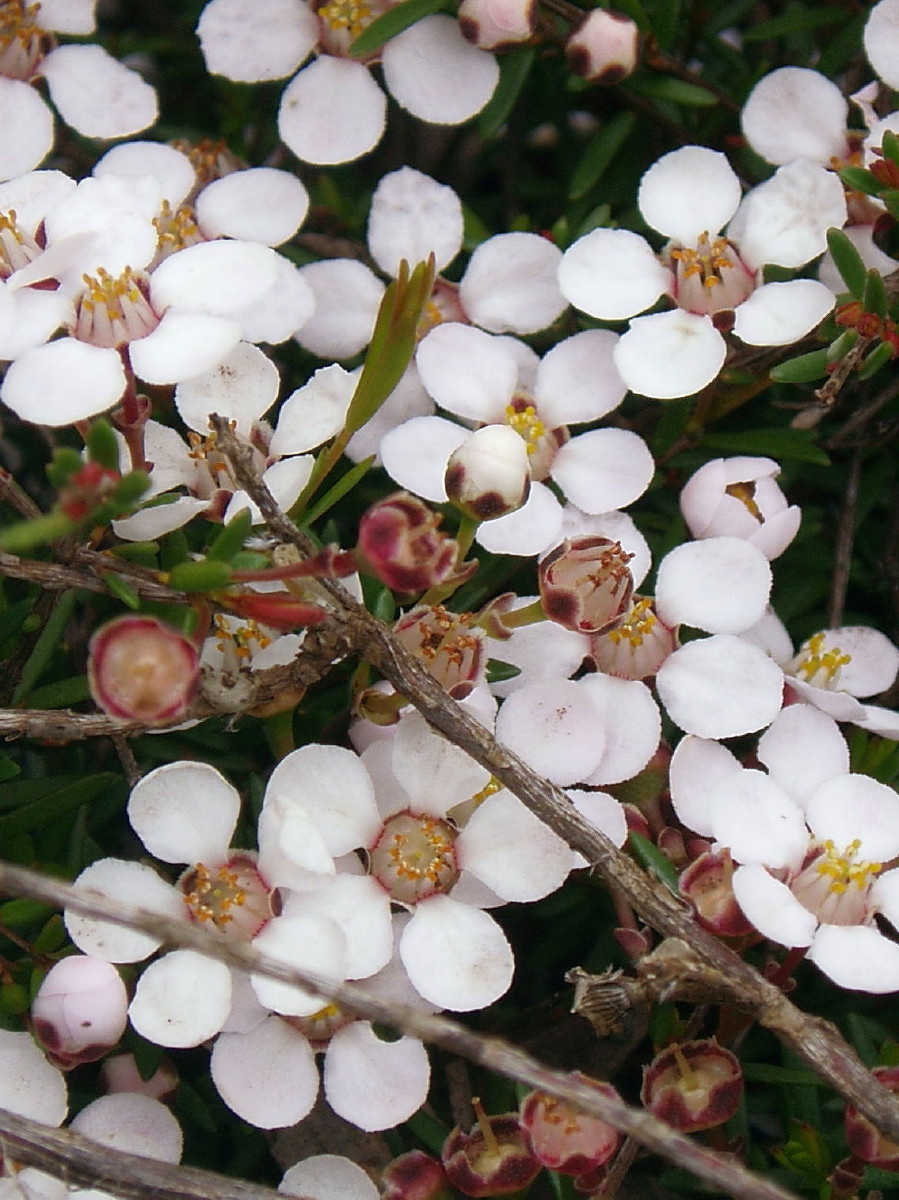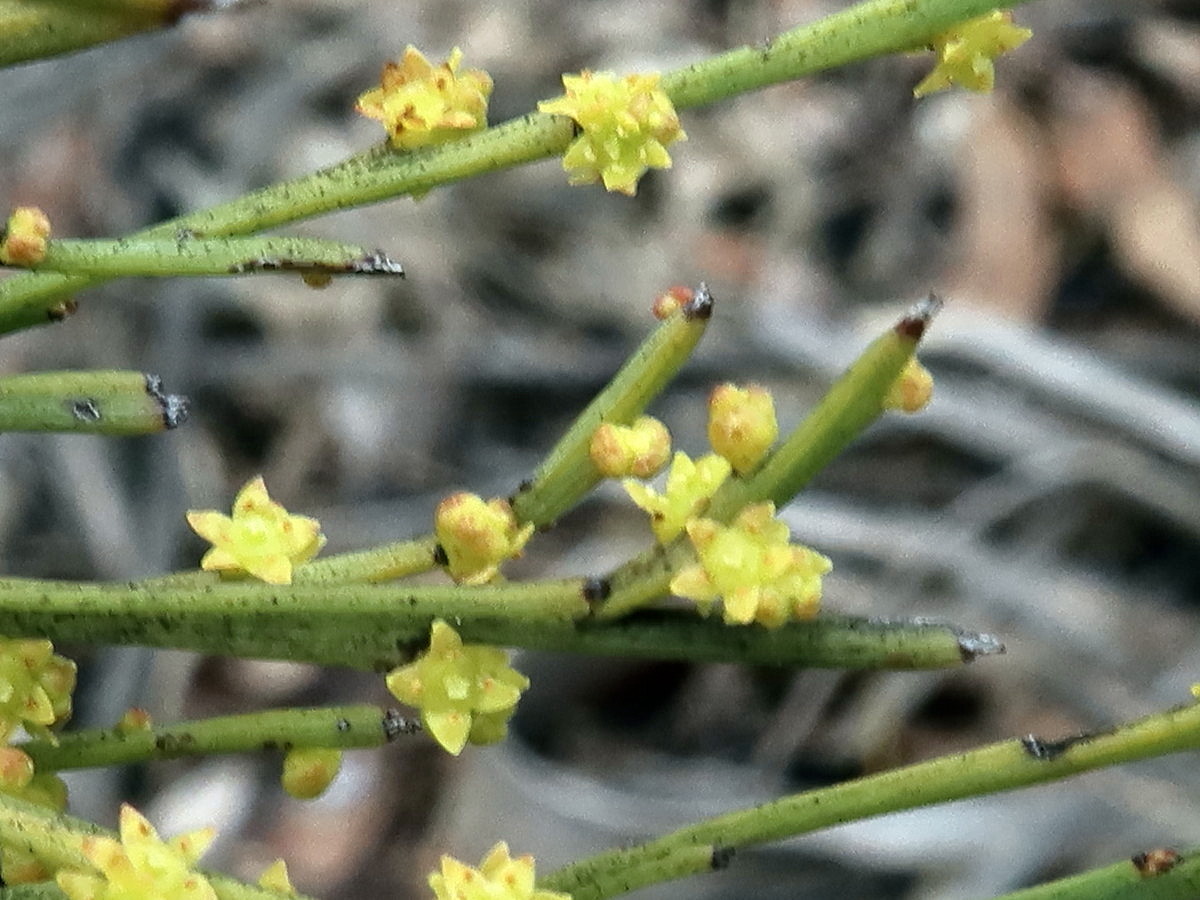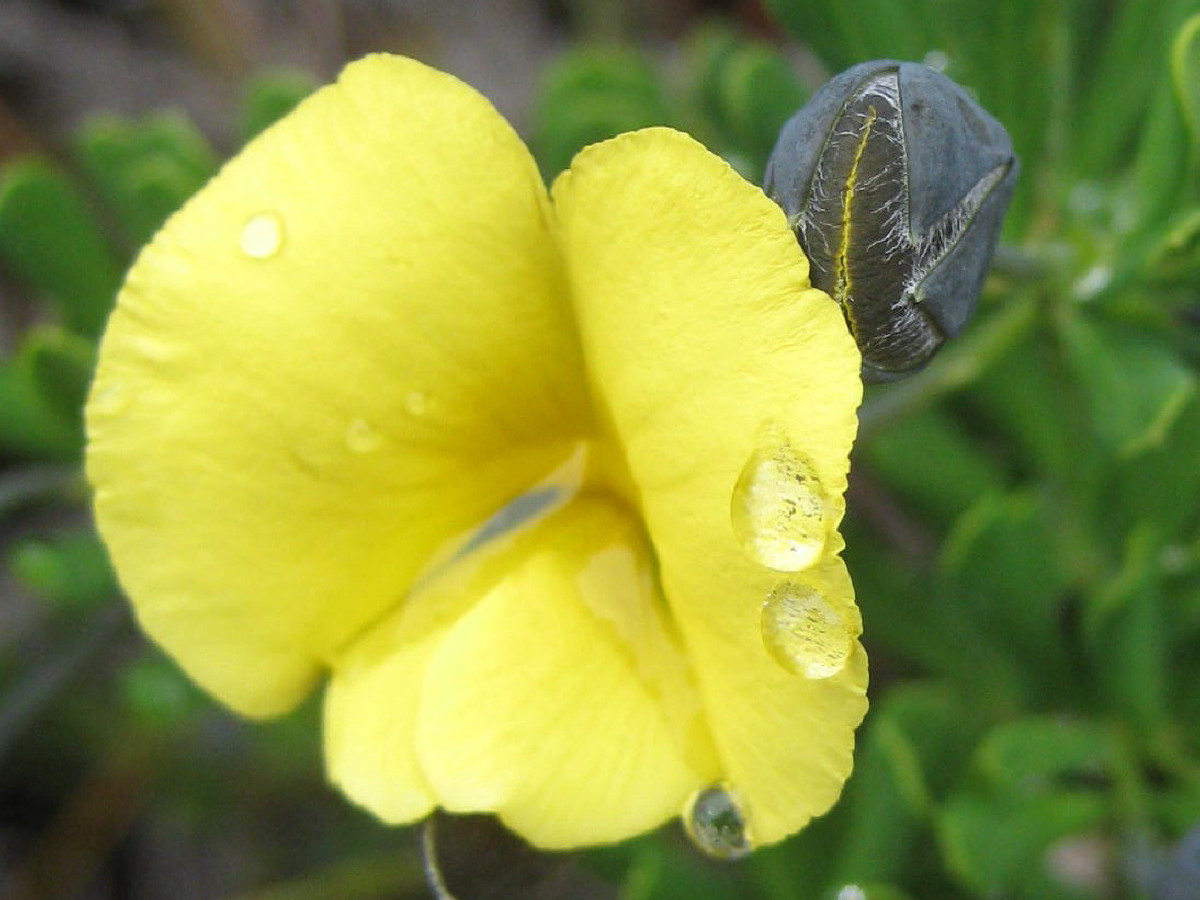Spring D-G
Looking at the photographs To view the photographs, click on the species image to enlarge it,
then use the side arrows to page through images of the flowers, buds, fruit, leaves, foliage and plant(s) in the wild etc.
Viewing the meaning of botanical words To view the meaning of botanical words, hold the cursor on the blue word and the meaning will appear in a text box. On phones, turn to landscape to view all.
Based on Debenham C’s, The Language of Botany, A Publication of The Society for Growing Australian Plants, Chipping Norton NSW, c.1962.
Daviesia latifolia
Botanical Name: Daviesia latifolia
Commonly Called: Hop bitterpea
Botanical Family: Fabaceae
Grows: This interesting shrub with large flat leaves and large simple racemes of flowers grows 1 to 2m high by 1 to 1.5m wide.
Foliage: The lanceolate leaves are undulating and leathery. They grow 2.5cm to 8cm long and 2 to 3cm wide and have a pronounced network of veins.
Flowers: The spikes of numerous gold and brown pea flowers grow from the leaf axils.
Flowering Season: The flowers appear throughout spring.
Fruit: The fruit is a triangular green pod, maturing to brown, containing seeds, each surrounded by an aril.
Habitat/distribution: An understorey plant of dry forests and roadsides. Also Vic, NSW and Q.
Where found: Knocklofty, Peter Murrell, Cheltenham Park, Tom Gibson and many other Reserves; kunanyi/Wellington Park lower areas; Meehan Range; Tasman, Douglas River, Narawntapu, Rocky Cape and other National Parks; Central Coast, Central Highlands, Derwent and Meander Valleys, Northern Midlands, St Marys Pass and West Coast.
Other notes: Distinguishing features are the broad leaves with prominent net veins, and the triangular pods. A hardy plant for a dry area with plentiful shade. Mass plantings could provide a colourful display.
Daviesia sejugata
Botanical Name: Daviesia sejugata
Commonly Called: Leafy spiky bitterpea
Botanical Family: Fabaceae
Grows: This densely-leaved prickly shrub with rigid, furrowed stems, tough needle-pointed leaves and large pea flowers grows 1 to 2m high by 1 to 1.5m wide.
Foliage: The new stems are like needles inhibiting browsing animals. The dark grey-green narrowly elliptic to obovoid, 15 to 33mm long by 2.5 to 5.5mm wide leaves developing alternately up the stems have a prominent central vein and terminate in a 2 to 4mm long point.
Flowers: The numerous golden yellow pea flowers with reddish markings grow from the leaf axils in 1 or 2 groups of 2 to 5 flowers on a 1.0 to 1.5mm long peduncle with each flower growing on a 2.0 to 4.5mm long pedicel. The 3 to 4.5mm long sepals are campanulate with 0.7 to 1.5mm long lobes. The broadly ovoid standard petal, about 6 to 7mm long by 6.5 to 7.5mm wide has a notched centre and is yellow with a maroon base and a bright yellow centre. The 6.3mm long wings are red with orange tips while the 5mm long keel is dark purple.
Flowering Season: The flowers appear throughout spring.
Fruit: The fruit is a flat, triangular 8 to 11mm long green pod, maturing to brown, containing a number of seeds.
Habitat/distribution: It is found in wet sclerophyll woodlands or forests. It is scattered in the north, but it is more common in the south-east. It is also indigenous in SA.
Where found: It has been recorded in Bluff River Gorge, Buckland; Bruny and King Islands; Coles Bay, Knocklofty Reserve, West Hobart; above Lunchtime Creek, Cape Pillar, Tasman Peninsula; Meehan Range, Cambridge; and other Reserves; near Interview River, West Coast; site of the ‘French Garden’, Recherche Bay; Van Morey Road, Margate; also a number of other locations throughout the state.
Other notes: The distinguishing features are the yellow flowers on the hard prickly branches, the leaf shape combined with the triangular pods. This species requires well-drained soil with some moisture and may be propagated from hot water treated seed.
Daviesia ulicifolia
Botanical Name: Daviesia ulicifolia subsp. ulicifolia
Commonly Called: Yellow spiky bitterpea
Botanical Family: Fabaceae
Grows: This open spinescent shrub with rigid stems, tough needle-pointed leaves and large yellow pea flowers grows 0.5 to 2m high by 0.5 to 1.5m wide.
Foliage: The branches are ribbed, glabrous to hispid and new stems have needle like tips. The green rarely ovate, normally narrow-elliptic or narrow-ovate, 5 to 35mm long by 0.5 to 6mm wide leaves which develop alternately up the stems are flat or convex above, have a prominent midrib and terminate in a 2 to 4mm long point.
Flowers: The numerous inflorescences grow from the leaf axils in 1 or 2 umbelliform groups of 2 to 5 pea flowers often only single, with reddish markings flowers on a 0.5 to 2mm long peduncle with each flower growing on a 1 to 1.5mm long pedicel, subtended by several oblong, about 1mm long, hooded bracts. The 2.5 to 3.5mm long calyx, including a 0.5 to 0.8mm long receptacle with acute tipped, equal teeth with fimbriate edges. The corolla is mainly orange-yellow and the elliptic standard is about 6mm long by about 5mm wide and mainly yellow-brown with a reddish brown centre.
Flowering Season: The flowers appear throughout spring.
Fruit: The fruit is a flat, triangular 5 to 12mm long by 2.5 to 6mm wide green pod, maturing to brown, containing 1 reniform, mottled seed about 4mm long.
Habitat/distribution: It is found in wet sclerophyll woodlands or forests. It is scattered in the north, but it is more common in the south-east. It is also indigenous in SA.
Where found: It has been recorded in Coningham, Echo Sugar Loaf Randalls Bay, Peter Murrell and Knocklofty West Hobart Reserves; Labillardiere Peninsula, Bruny Island; Tolmans Hill; Cape Barren, Clarke and Flinders Islands; Mount Cameron; Freycinet, Narawntapu, Rocky Cape and Tasman National Parks, also a number of other locations throughout the state.
Other notes: The distinguishing features are the yellow flowers on the hard prickly branches, the leaf shape combined with the triangular pods. This species requires well-drained soil with some moisture and may be propagated from hot water treated seed. Daviesia sejugata has broader leaves than Daviesia ulicifolia subsp. ulicifolia and Daviesia ulicifolia subsp. ruscifolia has orange flowers which differs it from yellow flowering Daviesia ulicifolia subsp. ulicifolia.
Diplarrena moraea
Botanical Name: Diplarrena moraea
Commonly Called: White flag-iris
Botanical Family: Iridaceae
Grows: This lovely plant grows 50 to 100cm high by 10 to 30cm wide.
Foliage: The stiff, erect, smooth leaves are ~1cm wide by 75cm long.
Flowers: The flower heads grow on stalks 20 to 105cm long. The 3 outer perianth segments, tepals, are large white oblanceolate to obovate shaped with a slight central ridge and each half is slightly concave.
Each large tepal has a shallow notch on its tip. The two inner tepals each side of the centre are mainly yellow on top with purple vein-like markings.
The central rear white tepal, tinged purple beneath, is concave hood-like over the stamens and style. Individual flowers only last a few days, but new ones emerge from the bud at the top of the stem. Thus the plant flowers over a long time.
Flowering Season: The flowers appear in spring but flowering can extend into summer.
Fruit: The fruit is a brown capsule containing many seeds.
Habitat/distribution: Common and widespread around Tasmania in a range of habitats from sea level to 1000m. Also found in Vic and NSW.
Where found: Throughout Tasmania especially open grassy areas; Meehan Range Nature Recreation Area; Knocklofty, Tom Gibson, Cheltenham Park, Conningham and many more Reserves; many Parks and National Parks; George Town, Latrobe, Flinders Island, Skullbone Plains, Waratah and many other places. Large swathes along the Lyell Highway, especially west of Derwent Bridge.
Other notes: Leaves and edges of leaves are smooth. Various forms exist in cultivation. Requires well-drained moist soil and full sun. Propagate by division of clumps, or from short life fresh seed.
Epacris impressa
Botanical Name: Epacris impressa
Commonly Called: Common heath
Botanical Family: ERICACEAE subfamily 4 EPACRIDOIDEAE tribe 5 EPACREAE genus 11 EPACRIS
Grows: This readily recognised epacris species grows 50 to 100cm high by 20 to 50cm wide.
Foliage: The spreading to recurved, stalkless leaves are narrow and taper to a sharp point. The younger branches are ribbed and tomentose. The older stems are bare with leaf scars. In coastal areas the salt laden breezes may cause denser leaf growth along the stems.
Flowers: The tubular flowers range in colour from creamy-white through pink to deep red and have 5 distinct indentations (impressions) at the stem end, hence the species name. They grow from the leaf axils along the length of the upper branches toward the tips.
Flowering Season: The flowers appear mainly in spring but also spasmodically in autumn and winter.
Fruit: The fruit are small 5-celled capsules.
Habitat/distribution: Epacris impressa is widespread and abundant in dry sclerophyll forests from sea level to 800m. It is also found in SA, Vic and NSW.
Where found: Throughout Tasmania especially in well-drained soil and dappled shade to full sun. All National Parks and many city parks and gardens; kunanyi/Wellington Park, Knocklofty, Peter Murrell, Risdon Brook, Tom Gibson and many other Reserves; Meehan Range Nature Recreation Area, Tangara Trail tracks in Acton Park and many other places.
Other notes: Prune after flowering for bushy shape and size in home gardens. The impressions at the base of the floral tubes are the distinguishing feature for this species.
Euryomyrtus ramosissima
Botanical Name: Euryomyrtus ramosissima
Commonly Called: Rosy heathmyrtle
Botanical Family: Myrtaceae
Grows: This small shrub grows prostrate to procumbent up to a height of about 60cm and it spreads 50 to 100cm wide, with wide spreading, diffuse and wiry branches which may often root at the nodes.
Foliage: The spreading or suberect, typically 2 to 10 and up to 15mm long by 0.5 to 2.0mm wide leaves are linear or narrowly lanceolate to elliptic-lanceolate or narrowly ovate with a rounded base, are flat to more or less concave. Their texture is slightly thickened and their edges are sometimes minutely ciliolate toward the apex which is acute.
Flowers: The single or rarely 2 axillary erect flowers have pedicels as long as or occasionally 2 to 3 times as long as the leaves. Their bracteoles are more or less cordate and are inserted about 1/2 to 2/3 along the pedicel. The broadly triangular brownish-purple sepals have a blunt, rounded apex and entire to minutely fimbriate edges. The 5, often glossy, 3 to 5mm diameter white, pale pink to mauve-purple petals sometimes have dark blotches and are orbicular with minutely ciliolate-fimbriate, crenulate edges and numerous floral trichomes. They have 10 or rarely fewer stamens and those opposite the petals are longer than those opposite the sepals. The large connective gland of the stamen is clavate.
Flowering Season: The flowers appear in spring.
Fruit: The fruit is an broadly obconic-hemispherical capsule to 3 to 4.5mm diameter full of fine brown seed..
Habitat/distribution: In Tasmania it is widespread and locally frequent in moist sandy heaths and light open forest and woodlands throughout Tasmania, locally in the west from sea level to 500m altitude. It also is found in SA, NSW and Vic.
Where found: It has been recorded in Freycinet, Bakers Beach- Narawntapu, Rocky Cape and Tasman National Parks; Bluff River Gorge, Buckland; Luther Point to Spring Beach Orford Coastal, Peter Murrell and Tarkine Reserves; St Helens Conservation area; Lake Leake Road, MacArthur Road junction, Lake Leake; Snug Tiers.
Other notes: The distinguishing features are the flowers with 10 fertile anthers on stems longer than the leaves. This species tolerates many soil types, periods of dry and prefers part sun and is useful for moist areas, especially rockeries. It grows well among other ground cover plants and is an ideal pot plant or in a hanging basket.
Exocarpos strictus
Botanical Name: Exocarpos strictus
Commonly Called: Pearly native-cherry
Botanical Family: Santalaceae
Grows: This small hemi-parasitic, erect, glabrous shrub grows 0.5 to 3.5m high and spreads 1 to 3m wide.
Foliage: The green or bronze-green striate branches usually have 2 or 3 prominent angles. They are often coarse, rigid and erect, but occasionally slim and spreading or with drooping ends. The subulate, 1 to 3mm long leaves normally grow only on very young shoots. When they are shed, they leave minute triangular, tooth-like bases.
Flowers: The approximately 2.5mm diameter flowers grow on very short peduncles or sessile in clusters of 2 to 4 along the lengths of the branches, occasionally clustered 2 to 3 together in the same axil. The flowers have 4 or 5 perianth lobes and both these forms of flowers often occur in the same cluster. These greenish-yellow lobes are sometimes tinged with red.
Flowering Season: The flowers appear in spring.
Fruit: The greenish-black ovoid-globular fruit is about 4mm long and grows on a white or occasionally red thickened and succulent pedicel which is slightly longer than the fruit.
Habitat/distribution: In Tasmania it is widespread at low altitudes in coastal bushland and eucalyptus woodlands in the east of the state. It is also indigenous in SA, Vic and NSW.
Where found: It is found in Tasman National Park; Badger, Clarke, Flinders, Maria and Tasman Islands; Dover; Georges Bay; Knocklofty, Molesworth, Orford Coastal Tracks & Thumbs and Peter Murrell Reserves; Kellevie, Molesworth, Mount Jacob, Mount Nelson, Port Arthur, Prosser River and its estuary, many locations around Hobart and the Derwent Estuary and other places around Tasmania.
Other notes: The distinguishing feature is the tough, sharply ridged stem with narrow grooves in between the ridges. This species is a hemi-parasitic plant and as such is not easily propagated.
Gompholobium huegelii
Botanical Name: Gompholobium huegelii
Commonly Called: Common wedgepea
Botanical Family: Fabaceae
Grows: This small, woody rootstock undershrub grows 15 to 30cm high by 30 to 60cm wide with spreading or ascending branches.
Foliage: The trifoliate leaves are shortly stalked and the 6 to 16mm long narrow linear to linear-obovate leaflets are glabrous and somewhat glaucous with blunt or mucronate apex.
Flowers: The terminal flowers are single or two together on slim peduncles much longer than the leaves. The 8 to 10mm long calyx have lanceolate lobes with glabrous, almost black outer surface and ciliate edges. The orbicular standard is longer than the calyx and all the creamy yellow petals also have almost black outer surface.
Flowering Season: The flowers appear in spring.
Fruit: The fruit is a very inflated ovoid pod longer than the calyx.
Habitat/distribution: In Tasmania it is widespread and abundant in sandy heaths. It also is found in Vic and NSW.
Where found: It has been recorded in Bruny, Cape Barren, Flinders, King and Schouten Islands; Freycinet, Rocky Cape and Tasman National Parks; Bridport Wildflower, Carr Villa, Peter Murrell, Mortimer Bay, the Tarkine, Tom Gibson, Western Explorer and Winifred Curtis Reserves; and many other places around Tasmania’s coastline and other inland locations.
Other notes: A distinguishing feature is the flowers on long fine stems without bracteoles. Useful for moist areas but will tolerate periods of dry, with some sun, among other ground cover plants.
UP TO HERE
Goodenia elongata
Botanical Name: Goodenia elongata
Commonly Called: Lanky native-primrose
Botanical Family: Goodeniaceae
Grows: This small herb grows prostrate to about 5cm with its leafy flower stalks up to 30cm high and spreads 30 by 50cm wide.
Foliage: Narrow, spatulate, 1 to 5cm long, with smooth edges, slightly hairy, widely spaced along the stem. Upper stem leaves smaller.
Flowers: The single flowers are yellow, to 2.5cm across, on a long fine stalks from the leaf axils.
Flowering Season: The flowers appear in spring.
Fruit: The fruit is an oval capsule to 6mm long.
Habitat/distribution: In Tasmania it is widespread and common in moist areas. It also is found in Vic.
Where found: It is found especially in moist areas in Freycinet and Tasman National Parks; Maria and Bruny Islands; some Reserves; Kellevie Road at the Carlton River Bridge.
Other notes: A distinguishing feature is the flowers on long fine stems without bracteoles. Useful for moist areas but will tolerate periods of dry, with some sun, among other ground cover plants.
Goodenia lanata
Botanical Name: Goodenia lanata
Commonly Called: Trailing native-primrose
Botanical Family: Goodeniaceae
Grows: This pretty little herb grows prostrate to 0.6 by 1.5m wide.
Foliage: The leaves grow from 1 to 8cm long by 0.5 to 2cm wide with toothed or lobed edges, obovate, narrowing to a long stem. Upper surface is dark green with scattered hairs and the lower surface is light green.
Flowers: The solitary flowers on stems 2 to 6cm long, are yellow with three spreading lower lobes and two erect upper lobes, and deeper colour in the centre with petal edges slightly wavy.
Flowering Season: The flowers appear throughout spring and into summer
Fruit: The fruit is an ovoid to cylindrical capsule, 5 to 6mm long.
Habitat/distribution: It is widespread, and grows in variable soils in dry to moist sites from coastal heath to woodlands. Also Vic.
Where found: Throughout the north, north east, midlands and south east in Tasmania. Freycinet and Tasman National Parks and some bushland parks and gardens; Wellington Park lower areas, Knocklofty and Peter Murrell Reserves; also along roadsides.
Other notes: Suitable for growing in well drained, moist soil with some sun. Forms from the Midlands are frost hardy while coastal forms are not.
Goodenia ovata
Botanical Name: Goodenia ovata
Commonly Called: Hop native-primrose
Botanical Family: Goodeniaceae
Grows: This attractive species grows 1 to 2m high by 0.5 to 1.5m wide.
Foliage: The leaves are bright green, slightly sticky and ovate with toothed edges. Mature leaves with short stems, grow from 2 to 6cm long on dark grey/green branches.
Flowers: The bright yellow flowers on long slender stems have petals with slightly wavy edges and consist of three spreading lower lobes and two upper lobes.
Flowering Season: The flowers are prolific in spring and sporadic throughout the year.
Fruit: The fruit is a narrow rounded capsule.
Habitat/distribution: This species is widespread in Tasmania and is a coloniser of roadsides and open forest especially after a bush fire. It is also found in SA, Vic, NSW and Q.
Where found: It is found occasionally on the west coast in Trial Harbour and Zeehan, in the Northern midlands and along the Nile and South Esk Rivers. It is more common along the northern coastal areas from Stanley to Bridport and down the east coast from Picnic Point to Orford. It is quite common in the south east including at Lime Bay, Carlton River, Derwent and Huon Valleys and as far south as Cockle Creek and South Cape Bay. It grows in the lower areas of kunanyi/Wellington Park, in many bushland parks and gardens including Knocklofty and Peter Murrell Reserves; in Freycinet and Tasman National Parks and Furneaux, Maria and Bruny Islands.
Other notes: Goodenia ovata is easily recognised by the many 5 lobed yellow flowers on a bright green rounded bush. it is a rapid coloniser in open forest areas after bush fires. It grows well in most soils in home gardens and is easy to propagate from semi-hard wood cuttings.
Goodia lotifolia
Botanical Name: Goodia lotifolia
Commonly Called: Smooth goldentip
Botanical Family: Fabaceae
Grows: The easily grown small tree grows 1 to 4m high by 1 to 2m wide.
Foliage: The foliage is tri-foliate leaflets 1 to 2.5cm long, having the mid-green upper surface with obvious reticulate veins.
Flowers: The flowers are terminal racemes of bright yellow pea flowers with red-brown throats.
Flowering Season: Flowers appear in spring
Fruit: The fruit is an oblong flattened brown pod which may be heard exploding on a warm day.
Habitat/distribution: Common on shaded hillsides throughout the state. Also WA, SA, Vic, NSW, Q.
Where found: King and the Furneaux Islands; North West, Northern and East coasts; Freycinet and Forestier/Tasman Peninsulas; Swansea, Lenah Valley and lower kunanyi/Wellington Park.
Other notes: Tolerates a variety of conditions and is a colourful addition to the garden. Following fruiting the branch dies, but if this is removed by pruning, more shoots will appear. The branches of this shrub are very brittle. Its open habit can be made more compact by careful pruning.
- Acacia axillaris Sp E
- Acacia dealbata Sp
- Acacia derwentiana Sp E
- Acacia genistifolia Sp
- Acacia gunnii Sp
- Acacia leprosa Sp
- Acacia melanoxylon Sp
- Acacia mucronata subsp. dependens Sp E
- Acacia mucronata-subsp.-longifolia Sp
- Acacia mucronata subsp. mucronata Sp E
- Acacia verticillata Sp
- Ajuga australis Sp
- Amperea xiphoclada Sp
- Anodopetalum biglandulosum Sp E
- Anopterus glandulosus Sp E
- Aotus ericoides Sp
- Aristotelia peduncularis Sp E
- Arthropodium strictum Sp
- Athrotaxis cupressoides Sp E
- Athrotaxis selaginoides Sp E
- Bauera rubioides Sp
- Bedfordia salicina Sp E
- Billardiera longiflora Sp E
- Blandfordia punicea Sp E
- Boronia citriodora Sp E
- Boronia gunnii E Sp
- Boronia pilosa Sp
- Bossiaea cinerea Sp
- Bossiaea riparia Sp
- Brachyscome spathulata Sp
- Bulbine glauca Sp
- Calytrix tetragona Sp
- Carpobrotus rossii Sp
- Chamaescilla corymbosa Sp
- Chrysocephalum apiculatum Sp
- Clematis aristata Sp
- Comesperma volubile Sp
- Coprosma quadrifida Sp
- Cyathodes glauca Sp E
- Daviesia latifolia Sp
- Daviesia sejugata Sp
- Diplarrena moraea Sp
- Dodonea filiformis Sp E
- Epacris acuminata Sp E
- Epacris impressa Sp
- Epacris virgata Sp E
- Eucalyptus risdonii Sp E
- Eucalyptus delegatensis subsp. tasmaniensis Sp E
- Eucalyptus tenuiramis Sp E
- Eucalyptus vernicosa Sp E
- Euryomyrtus ramosissima Sp
- Exocarpos strictus Sp
- Goodenia elongata Sp
- Goodenia lanata Sp
- Goodenia ovata Sp
- Goodia lotifolia Sp
- hakea-epiglottis subsp. epiglottis Sp E
- Hakea lissosperma Sp
- Hardenbergia violacea Sp
- Hibbertia appressa Sp
- Hibbertia procumbens Sp
- Hibbertia riparia Sp
- Hibbertia sericea var sericea Sp
- Indigofera australis Sp
- Kennedia prostrata Sp
- Kunzea ambigua Sp
- Lasiopetalum micranthum Sp E
- Leptecophylla parvifolia Sp E
- Leptospermum nitidum Sp E
- Lissanthe strigosa Sp
- Melaleuca pustulata Sp E
- Melaleuca virens Sp E
- Milligania densiflora Sp E
- Odixia achlaena Sp E
- Olearia archeri Sp E
- Olearia phlogopappa Sp
- Orites acicularis Sp E
- Orites revolutus Sp E
- Oxylobium ellipticum Sp
- Ozothamnus scutellifolius Sp E
- Patersonia fragilis Sp
- Phebalium daviesii Sp E
- Pimelea drupacea Sp
- Pimelea nivea Sp E
- Pimelea sericea Sp E
- Pomaderris pilifera subsp. talpicutica Sp E
- Richea pandanifolia Sp E
- Spyridium obovatum var. obovatum Sp E
- Spyridium obovatum var. velutinum Sp E
- Spyridium ulicinum Sp E
- Stackhousia monogyna Sp
- Stylidium graminifolium Sp
- Tetratheca gunnii Sp E
- Thelionema caespitosum Sp
- Trochocarpa thymifolia Sp E
- Veronica formosa E Sp
- Vittadinia muelleri Sp
- Westringia angustifolia Sp E
- Westringia brevifolia Sp E
- Westringia rubiifolia Sp E
- Zieria arborescens Sp
- Australian bugle Sp
- Beaked needlebush Sp E
- Blackwood Sp
- Blue lovecreeper Sp
- Blue stars Sp
- Bluish bulbine-lily Sp
- Blunt caterpillar wattle Sp E
- Broom spurge Sp
- Bushmans bootlace Sp E
- Button-leaf everlastingbush Sp E
- Central lemon boronia Sp E
- Cheeseberry Sp E
- Cherry riceflower Sp
- Chocolate lily Sp
- Christmas bells Sp E
- Claspleaf heath Sp E
- Common Everlasting Sp
- Common fringemyrtle Sp
- Common heath Sp
- Common speedwell bush Sp E
- Davies waxflower Sp E
- Derwent wattle Sp E
- Dusty daisybush Sp
- Erect caterpillar wattle Sp
- Erect guineaflower Sp
- Fineleaf hopbush Sp E
- Forest candles Sp
- Golden everlastingbush Sp E
- Golden pea Sp
- Golden shaggypea Sp
- Gumtopped stringybark Sp E
- Heartberry Sp E
- Hairy boronia Sp
- Hop bitterpea Sp
- Hop native-primrose Sp
- Horizontal Sp E
- Huon pine Sp E
- King Billy pine Sp E
- Lanceleaf daisybush Sp E
- Lanky native-primrose Sp
- Leafless bossia Sp
- Leafy spiky bitterpea Sp
- Longleaf caterpillar wattle Sp
- Midlands wattle Sp E
- Moleskin dogwood Sp E
- Mountain clematis Sp
- Mountain pinkberry Sp E
- Mountain riceflower Sp E
- Narrowleaf triggerplant Sp
- Narrowleaf westringia Sp E
- Native currant Sp
- Native indigo Sp
- Native pigface Sp
- Peachberry heath Sp
- Pearly native-cherry Sp
- Prickly moses Sp
- Pandani Sp E
- Pencil pine Sp E
- Ploughshare wattle Sp
- Pretty heath Sp E
- Prickly bottlebrush Sp E
- Prickly moses Sp
- Purple appleberry Sp E
- Purple coral-pea Sp
- Revolute orites Sp E
- Risdon peppermint Sp E
- River boronia Sp E
- Rosy heathmyrtle Sp
- Running postman Sp
- Scented dustymiller Sp E
- Shiny teatree Sp E
- Shortleaf westringia Sp E
- Short purpleflag Sp
- Showy bossia Sp
- Shy pinkbells Sp E
- Silky guineaflower Sp
- Silky milligania Sp E
- Silver peppermint Sp E
- Silver wattle Sp
- Smooth dustymiller Sp E
- Smooth goldentip Sp
- Southern guineaflower Sp
- Spoonleaf daisy Sp
- Spreading guineaflower Sp
- Spreading wattle Sp
- Sticky westringia Sp E
- Stinkwood Sp
- Tasmanian blanketleaf Sp E
- Tasmanian laurel Sp E
- Tasmanian velvetbush Sp E
- Thymeleaf purpleberry Sp E
- Trailing native-primrose Sp
- Tufted lily Sp
- Urn gum Sp E
- Varnish wattle Sp
- Velvet dustymiller Sp E
- Warty paperbark Sp E
- White flag-iris Sp
- White kunzea Sp
- Wiry bauera Sp
- Yellow orites Sp E

